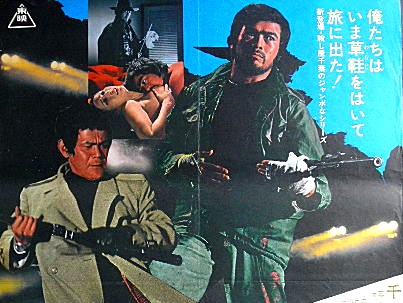
The “Check The Back Shelf” series will take a look at the weirder world of cinema that video stores provided beyond the “New Releases” section, often these unusual treasures were in the back of the shop, tucked away from the casual movie fans. B-movies, horror, foreign films, rare bootlegs and more will be touched on here in the coming days.
by Matthew Essary (Twitter: @WheelsCritic)

“Imitation is the sincerest form of flattery. . . ”
When essayist, Charles Caleb Colton uttered this famous quote, he could not have known how well it would apply to so many modern-day situations, as a film enthusiast it immediately makes me think of the explosion of films that arrived in the wake of Sergio Corbucci’s seminal 1966 Italian western, DJANGO. Corbucci’s gritty tale of a coffin-dragging, post-Civil War Union soldier who wanders into a conflict between warring factions in a nearly deserted border town, was such a success in its native country, that dozens of unofficial Django films were produced – possibly due to media copyright laws being almost nonexistent in Italy at the time. A few noteworthy examples of these films include:
A FEW DOLLARS FOR DJANGO
DJANGO SHOOTS FIRST
DJANGO KILL… IF YOU LIVE, SHOOT!
SON OF DJANGO
DJANGO was not just a success in Italy though. The use of “non-sync sound”, the Italian filmmaking practice of recording films with no audio on set and then dubbing them into various languages during post-production, led to them being seen all over the world and influencing countless filmmakers. This caused references to DJANGO’s story and iconography to pop up in various films, television shows, and games from many different countries over the years. The most famous of which is Quentin Tarantino’s 2012 “spaghetti western” homage DJANGO UNCHAINED.
As noteworthy as Tarantino’s DJANGO UNCHAINED is— and it is unquestionably the most famous of the DJANGO lineage, and fascinating in how it forwards the character in Tarantino’s cinematic pantheon—I’m not here to talk about that film though. I’m here to tell you about what may not only be the most obscure DJANGO-inspired film but also one of the most daring. I am here to tell you about Sonny Chiba’s 1972 film YAKUZA WOLF: I PERFORM MURDER (aka ÔKAMI YAKUZA: KOROSHI WA ORE GA YARU).

Shin’Ichi “Sonny” Chiba (best known to western audiences as Hattori Hanzo from Tarantino’s KILL BILL VOL. 1) at the time was an actor and stuntman for the Toei film studio of Japan. During this period, The Japanese film industry still operated under a studio-centric system similar to that of “Golden Age” Hollywood, where performers were exclusive to a single film studio. Chiba, who had been a mainstay of the Toei stable of actors since the 1960’s, had not yet had his breakout starring role as “Takuma ‘Terry’ Tsurugi” in the heavily influential cult martial arts film THE STREET FIGHTER but was still often called on by the studio when they needed an actor with a strong presence and physically intimidating stature. Chiba with his gruff yet charismatic demeanor and his legitimate martial arts experience (he holds high ranks in a variety of martial arts disciplines) had developed into a mid-level star for the studio by the time he was cast as “Gosuke Himoru”, the titular “Yakuza Wolf”.

YAKUZA WOLF was directed by Ryuichi Takamori, another utility member of the Toei studio. He directed low budget crime films for the studio that were meant to run as double features with other similar films. The projects (several with Chiba in the lead) were shot fast with low budgets but high amounts of violence, nudity, and questionable moral choices. YAKUZA WOLF was intended to be one of these quick double billers. For unknown reasons Takamori and screenwriter Fumio Konami found unexpected inspiration for the film in Corbucci’s DJANGO and that strange choice coupled with Chiba’s enduring popularity among cult film fans have caused this film to rise from obscurity and become a sought-after cinematic oddity more than 40 years after its initial release.

The film (set in the modern-day Japan of 1972) opens with several different Yazuka (i.e. Japanese mafia) being assassinated by a mysterious figure who, clad in a black duster and wide-brimmed hat, looks as if he could have stepped out of a western himself. He dispatches the men in efficiently brutal ways, attacking them silently, before they have a chance to defend themselves. This is Chiba’s introduction in the film and while it may not be as iconic as Franco Nero’s Django dragging a coffin into a western town stoicly, it does quickly establish the “Yakuza Wolf” as a dangerous man who puts winning above honor, much like his Italian inspiration.
In the original DJANGO, you don’t learn the hero’s motivations of vengeance and greed until the final third of the film. In YAKUZA WOLF however, after the opening montage of violent attacks, we flashback to a battle in the streets between rival Yakuza groups, the Himuro clan and the Onuma. The Himuro clan is decimated, their leader is gunned down and his daughter is abducted. Now months later, Chiba’s Gosuke has returned to avenge the death of his apparent father, the slain head of the Himuro clan and rescue his sister.

There are a couple of strong references to DJANGO as the story begins to unfold. As Chiba’s Gosuke enters the city looking for the Onuma he sees a group of their members assaulting a local prostitute. This parallels Django coming across the masked Confederates who are assaulting a woman at the beginning of Corbucci’s film. Except here, the nihilism is ratcheted up as Gosuke does not save the woman as his Italian counterpart did. He waits until after the assault and follows the thugs to a bar where the Onuma congregate. This brings to mind the saloon in Django that is a central set for the first act of the film. Once there at the bar, he falls more in line with the Corbucci’s Django and makes known his intentions while at the same time becoming romantically involved with one of the women who works at the establishment.

As the film progresses, Chiba’s character works to pick off the Onuma gang while forming a tenuous alliance with one of their rival clans. Again, this feels like an echo of DJANGO where the protagonist teamed with the Mexican soldiers to battle and rob their rival, the racist Confederates. Chiba eventually finds himself against both groups. Bloody battles with guns, knives, and fists are the only way it will all be sorted out by the end.
Although for a majority of the runtime of YAKUZA WOLF, the film diverges from the DJANGO template (there is no iconic Gatling gun or stolen gold, for example), the harmonica and horn-infused score by composer Toshiaki Tsushima and the wide framing of the camera shots by Takamori never let you forget the film’s spaghetti western influences. It works to establish it’s own lurid identity as well, with moments like Gosuke rescuing his kidnapped sister from a psychedelic sex den that could only exist in an exploitation film produced in the early 70’s or in the final shoot out, that takes place in front of yet another kidnapping victim, who is suspended above the battle on a giant cross (yes… really). Speaking of the finale, As the film ramps up to its bullet-riddled conclusion – the biggest homage to the original DJANGO becomes apparent.
Chiba is battling with a hired assassin and gets both of his hands severely damaged in a losing effort. He’s left alive and mocked as no longer a threat but in the climax of the film, he engages in a shootout with the few remaining bad guys using guns that he affixed to stationary objects around the battlefield so that he could fire them without the use of his fingers. It’s a thrilling confrontation that does justice to the all-time great, inventive ending of the final shootout in DJANGO where the title character, also with broken hands, does the same with his six-shooters in a cemetery.

YAKUZA WOLF: I PERFORM MURDER is a must watch for Sonny Chiba completists and an interesting curiosity for fans of spaghetti westerns. The acting and grindhouse aesthetics carry the film well. However, the directing of the action scenes that don’t involve gunfire is clunky and poorly edited which is a shame since Chiba is such a gifted physical performer. To me, this is a minor complaint for such an unusual and frankly… cool film. If you want to see how well the vibe of western films from Italy can be transplanted to a completely different time and place, then I strongly suggest tracking down this one from the internet. Unfortunately, the film has never had an official release in America but it’s worth the effort to locate.

